
Specifications
42
Manta Technical Manual V8.0.1
Sensor tap mode (CCD model series only)
With dual-tap sensor mode you can achieve a higher frame rate than with one-tap
mode. With one-tap sensor mode, you can achieve an image certain to be free of
any tap-boundary artifacts. You can also use one-tap mode if you experience tap
imbalance issues with your camera. You can change the sensor digitization tap
mode in Vimba Viewer 2.0 or later. Applicable to dual-tap cameras as detailed in
the specification tables.
Image acquisition must be stopped before changing sensor tap mode.
Affected features
This table lists features which are affected when switching from dual-tap to
one-tap sensor mode.
Absolute QE plots
Before reading the QE plots
•
All measurements were done without protection glass or IR cut filter. With
protection glass or filters, QE decreases by approximately 10%.
•
The uncertainty in measurement of the QE values is
10.25%. This is mainly
due to uncertainties in the measuring apparatus itself (Ulbricht sphere,
optometer). Manufacturing tolerance of the sensor increases overall
uncertainty.
•
The measurements for Manta G-145B NIR were done with a different method
to illustrate the effect of the NIR mode.
Sony CCD and CMOS sensors
Sony provides relative response curves in their sensor data sheets. To create the
absolute QE plots shown in this chapter, the relative response was converted to a
normalized QE response and then adjusted as per three measured QE values
(at 448 nm, 529 nm, 632 nm) for color sensors and one measured QE value
(at 529 nm) for monochrome sensors.
Feature
Dual-tap mode
One-tap mode
ReverseX
Available
Not available
ReverseY
Available
Not available
DecimationHorizontal
Available
Not available
DecimationVertical
Available
Not available
Table 6: Features affected when switching sensor tap mode
















































